It looks like you're using an Ad Blocker.
Please white-list or disable AboveTopSecret.com in your ad-blocking tool.
Thank you.
Some features of ATS will be disabled while you continue to use an ad-blocker.
share:
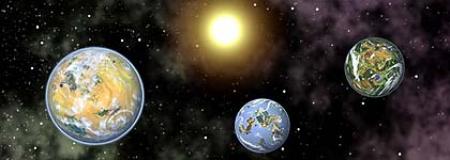
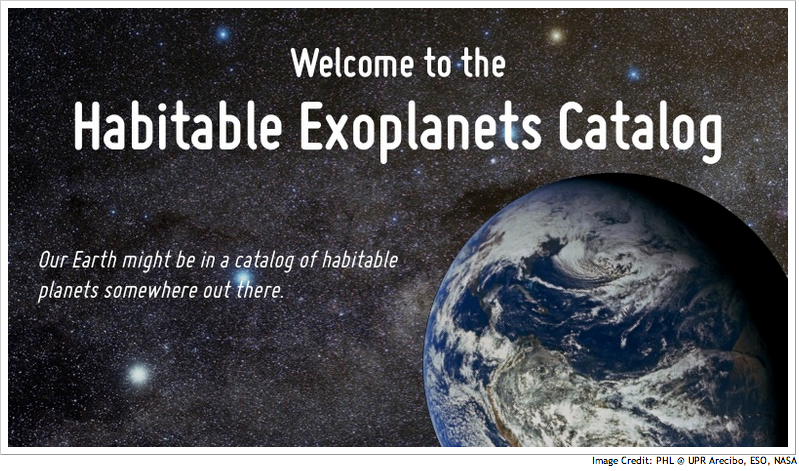
Wednesday could be an interesting day.
Here is the press release.... It doesn't give many details of what may be revealed in the latest batch of Kepler planets but I have good reason to believe they have confirmed a planet close to exactly the same size as the Earth in the 'goldilocks zone' of a star.
While other habitable exoplanets have been confirmed, they have all been slightly to more than twice the size of the Earth.
They have also found planets like Kepler 78b which while Earth size, orbit too close or too far from their stars for liquid water.
So that elusive Earth Twin has remained out there to be discovered or confirmed.
Perhaps it has?
Having the guy from the SETI Institute there is the tip off. Don't get too excited. The SETI Institute researches everything from how intelligent aliens might be detectable to things like extremophiles on Earth to dolphin communication. Of course they also research exoplanets.
However having both Sara Seager (who is probably THE leading astronomer in the field of exoplanet atmospheres) -AND- Jason Rowe of SETI does raise an eyebrow.
WASHINGTON, Feb. 21, 2014 /PRNewswire-USNewswire/ -- NASA will host a news teleconference at 1 p.m. EST, Wednesday, Feb. 26, to announce new discoveries made by its planet-hunting mission, the Kepler Space Telescope.
The briefing participants are:
Douglas Hudgins, exoplanet exploration program scientist, NASA's Astrophysics Division in Washington
Jack Lissauer, planetary scientist, NASA's Ames Research Center, Moffett Field, Calif.
Jason Rowe, research scientist, SETI Institute, Mountain View, Calif.
Sara Seager, professor of planetary science and physics, Massachusetts Institute of Technology, Cambridge, Mass.
Launched in March 2009, Kepler was the first NASA mission to find Earth-size planets in or near the habitable zone -- the range of distance from a star in which the surface temperature of an orbiting planet might sustain liquid water. The telescope has since detected planets and planet candidates spanning a wide range of sizes and orbital distances. These findings have led to a better understanding of our place in the galaxy.
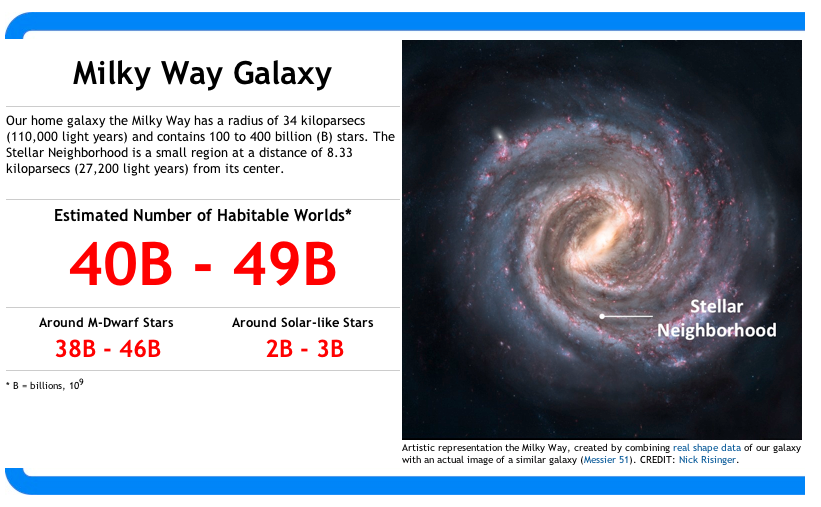
For dial-in information, media should e-mail their name, affiliation and telephone number to J.D. Harrington at [email protected] no later than noon, Wednesday.
The public is invited to listen to the teleconference live via UStream, at:
www.ustream.tv...
Questions can be submitted on Twitter using the hashtag #AskNASA.
Audio of the teleconference also will be streamed live at:
www.nasa.gov...
A link to relevant graphics will be posted at the start of the teleconference on NASA's Kepler site:
www.nasa.gov...
A true "Earth Analog" has been the holy grail of the Kepler program and there is a whole list of planetary candidates which if confirmed would become one.
Some of these Planet Candidates as you can see below, have an ESI (Earth Similarity Index) number as high as 0.94 or 94% similar to Earth!

For comparison here are the numbers for Earth and Mars as well as confirmed Earthlike exoplanets.
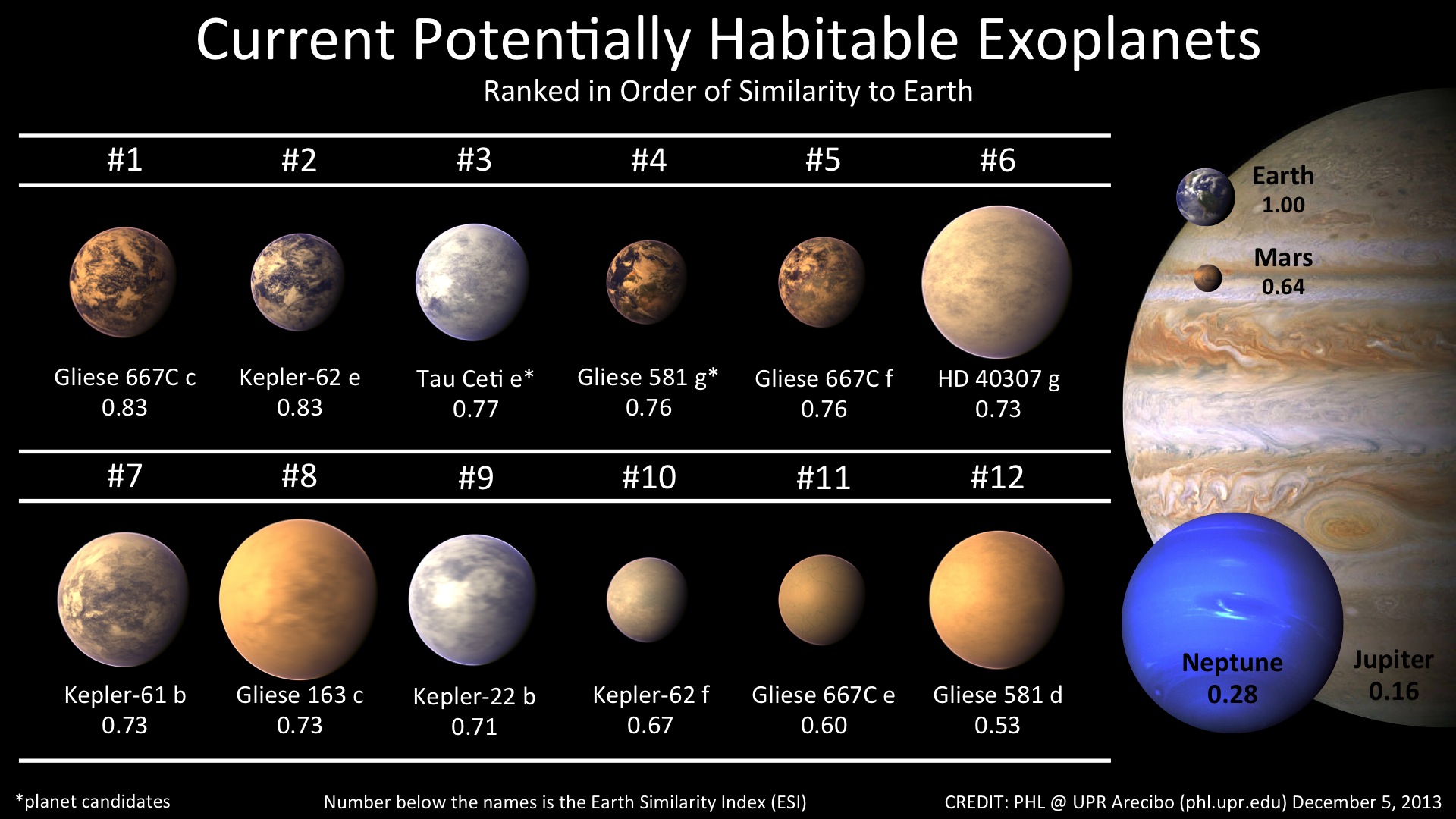
And lastly here is the Planetary Class scale so you know what a Class M, Class P, Class T, Class ht, etc, planet is:
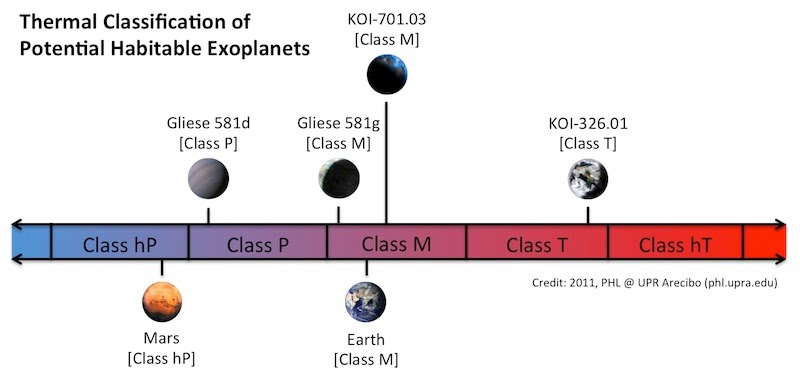
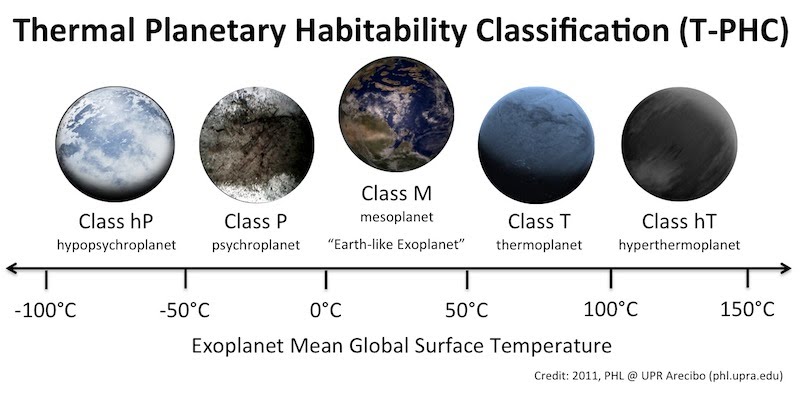
edit on 24-2-2014 by JadeStar because: (no reason given)
Thanks for the heads up JadeStar. Realistically, the universe is too vast and it's probably not too far off in our distant future that we find out
there are many Earth-Twins, and not too far off from that time, we may find they are booming with life. Interesting times indeed!
Rezlooper
Thanks for the heads up JadeStar. Realistically, the universe is too vast and it's probably not too far off in our distant future that we find out there are many Earth-Twins, and not too far off from that time, we may find they are booming with life. Interesting times indeed!
Yep. I am buzzing We live in the most interesting era of discovery perhaps since the days of Galileo and Copernicus! It is likely a matter of when, not if, other life is detected.
Most in the field suspect it will happen within the next 30 years. Perhaps even sooner. Like the video says at the end: Keep looking up.
edit
on 24-2-2014 by JadeStar because: (no reason given)
reply to post by JadeStar
How awesome would it be to go swimming at the beach on another planet with no other human on it. Probably have sharks with each tooth as big as 6ft long and Trex as big as a mouse.
How awesome would it be to go swimming at the beach on another planet with no other human on it. Probably have sharks with each tooth as big as 6ft long and Trex as big as a mouse.
Oooh, thanks for the heads-up, Jade! We have the NASA channel (my youngest loves the kid-oriented education shows on it & the feeds from the ISS)
I'll have to tune in
That sure would be an experience For me, it would be the emotions that would come from looking up & seeing a different night's sky. THAT view would be something to behold.
Abavs
reply to post by JadeStar
How awesome would it be to go swimming at the beach on another planet with no other human on it. Probably have sharks with each tooth as big as 6ft long and Trex as big as a mouse.
That sure would be an experience For me, it would be the emotions that would come from looking up & seeing a different night's sky. THAT view would be something to behold.
Abavs
reply to post by JadeStar
How awesome would it be to go swimming at the beach on another planet with no other human on it. Probably have sharks with each tooth as big as 6ft long and Trex as big as a mouse.
Or..... a Class-M planet around a sunlike star that is about half the age of our Sun for example.
One could just as much imagine a sea with no multicellular life, just simple single cell organisms.
That ocean would be one of the bluest oceans in the galaxy!
Kinda like the Earth was 2 billion years ago when it had enough oxygen for you or me to breathe but multicellular life had not yet evolved.
edit on 24-2-2014 by JadeStar because: (no reason given)
reply to post by JadeStar
Im pretty sure if one human went there it would pollute the planet with earth germs.
Im pretty sure if one human went there it would pollute the planet with earth germs.
edit on 24-2-2014 by Abavs because: (no reason given)
reply to post by Abavs
Well, earths size with what makes up its breathable atmosphere with the vibration frequency the earth with how fast it rotates, how close the sun is and its moon. They all contribute influence of how the human body functions and grows. If we were to goto another planet over time and generations we would mutate to be in sync with that planets influences.
Well, earths size with what makes up its breathable atmosphere with the vibration frequency the earth with how fast it rotates, how close the sun is and its moon. They all contribute influence of how the human body functions and grows. If we were to goto another planet over time and generations we would mutate to be in sync with that planets influences.
edit on 24-2-2014 by Abavs because: (no reason given)
Nyiah
Oooh, thanks for the heads-up, Jade! We have the NASA channel (my youngest loves the kid-oriented education shows on it & the feeds from the ISS) I'll have to tune in
Abavs
reply to post by JadeStar
How awesome would it be to go swimming at the beach on another planet with no other human on it. Probably have sharks with each tooth as big as 6ft long and Trex as big as a mouse.
That sure would be an experience For me, it would be the emotions that would come from looking up & seeing a different night's sky. THAT view would be something to behold.
Yes. Something like this......
From the potentially habitable planet Tau Ceti e, 11 light years from Earth:
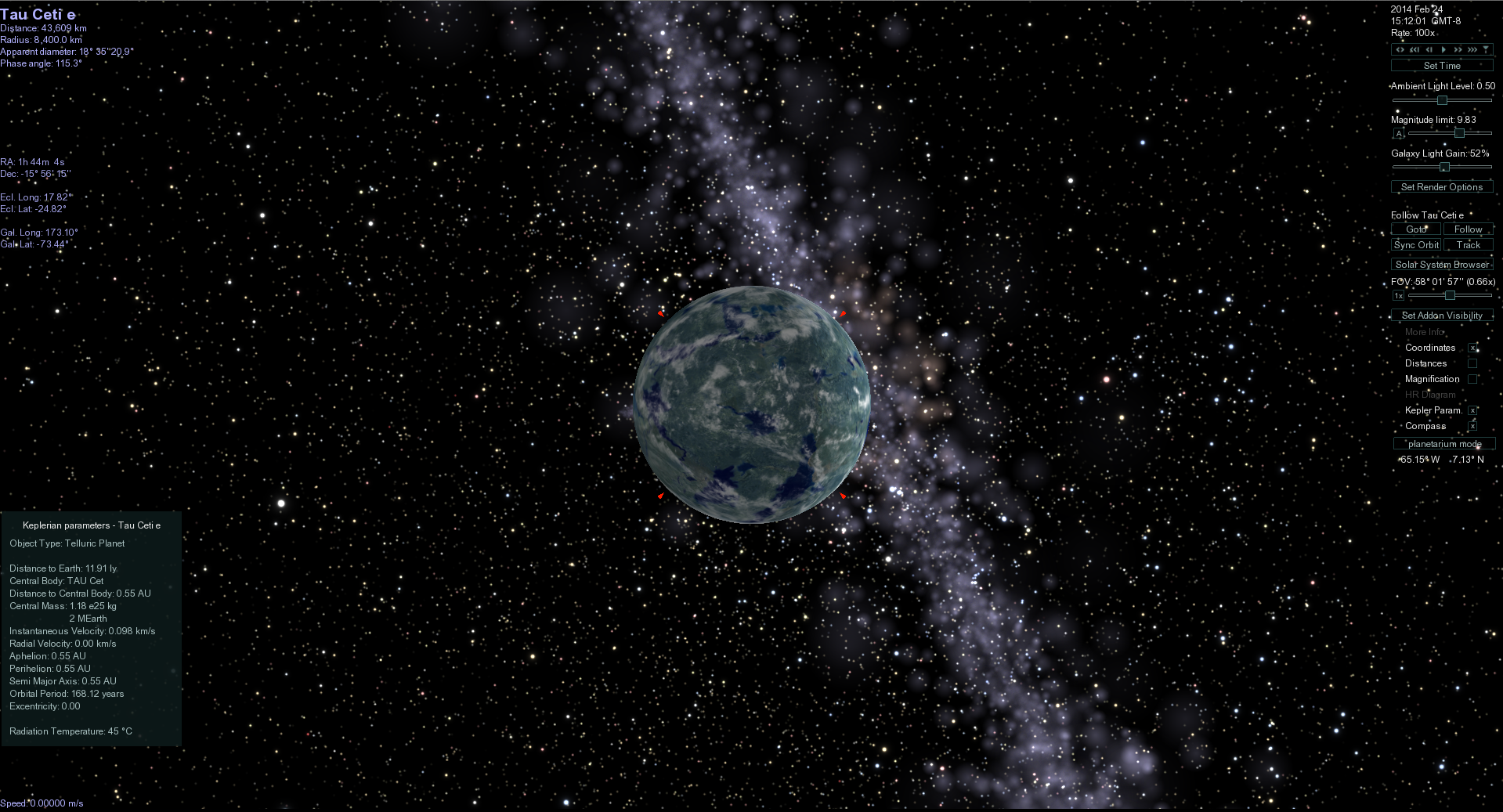
....if you were at the right latitude you would be able to get a glimpse of our Sun (Sol) at dusk as Tau Ceti set on the horizon.
It would be a bright yellow star perhaps looking orange and flickering on the horizon (due to Tau Ceti e's atmosphere if it turns out to be similar in make up to Earths). It would not be as bright as the planet Venus looks though. Perhaps about 2/3rds as bright as Venus.
It would be in the Constellation Bootes, just to the left and below Arcturus.

So you might sit out on your deck watching both Tau Ceti and your old home, The Sun, set on the horizon (both stars would rise and set together)
edit on 24-2-2014 by JadeStar because: (no reason given)
edit on 24-2-2014 by JadeStar because: (no reason
given)
Abavs
reply to post by JadeStar
Im pretty sure if one human went there it would pollute the planet with earth germs.
edit on 24-2-2014 by Abavs because: (no reason given)
Sure.
However, without knowing whether life there would have the same "handedness" of DNA that might not have any effect. All DNA on Earth is of one variety.
They call this chirality or handedness of DNA.
The earth could be polluted with extraterrestrial DNA of the left handed variety and it would never interact with our right handed DNA.
This idea is called a "shadow biosphere".
This video explains chirality well:
Oh wooow..thats make my heart dancing, cant wait until we find the way to go there..very great info tqx so much for sharing my friend! I will spread
the information to my friend..
reply to post by JadeStar
I'll be listening in, thanks for the heads up. Fun times.
If Kepler has looked at such a very tiny portion of one average galaxy, and not only found so many exoplanets but now the possibility of a near analog to Earth, then to quote and then paraphrase Carl Sagan....billions and billions (or trillions and trillions).
I'll be listening in, thanks for the heads up. Fun times.
If Kepler has looked at such a very tiny portion of one average galaxy, and not only found so many exoplanets but now the possibility of a near analog to Earth, then to quote and then paraphrase Carl Sagan....billions and billions (or trillions and trillions).
reply to post by JadeStar
Hi Jade thanks for the interesting information. I'll be checking back to see what the discoveries were. Can you clarify something for me? I was under the impression that we still don't have any way of verifying what an extrasolar planet is actually made up of. So while we can infer that the chances of a planet being habitable are higher if it's in the "goldilocks zone", we still don't have the ability to actually discern what that planets atmosphere consists of, so we really can't tell if a planet is actually habitable or not?
Even if there is an earth sized planet orbiting it's star at the perfect distance, couldn't the atmosphere be made up of say helium or some other concoction of gases that could render the planet uninhabitable for human beings, and we'd still have no idea if this is the case? Isn't it sort of just speculation at this point until our technology advances further?
Hi Jade thanks for the interesting information. I'll be checking back to see what the discoveries were. Can you clarify something for me? I was under the impression that we still don't have any way of verifying what an extrasolar planet is actually made up of. So while we can infer that the chances of a planet being habitable are higher if it's in the "goldilocks zone", we still don't have the ability to actually discern what that planets atmosphere consists of, so we really can't tell if a planet is actually habitable or not?
Even if there is an earth sized planet orbiting it's star at the perfect distance, couldn't the atmosphere be made up of say helium or some other concoction of gases that could render the planet uninhabitable for human beings, and we'd still have no idea if this is the case? Isn't it sort of just speculation at this point until our technology advances further?
edit on 24-2-2014 by DeadSeraph because: (no reason given)
I wouldn’t get too exited though.
I mean just because it’s the same size as earth and in the habitable zone doesn’t necessarily mean its habitable.
I mean there’s so many other factors.
1) Is there water? No water no show.
2) Atmosphere. Ok we have the obvious of is it breathable. But also its density can determine if the planets too hot or too cold too.
3) Tectonic activity. If it’s got super volcanoes going off all the time it’s not that great.
4) Other nearby planetary body’s. How do they affecting the weather? Are they pumping out radiation?
Not to be a party pooper but there are other factors that size and distance from the sun.
I mean just because it’s the same size as earth and in the habitable zone doesn’t necessarily mean its habitable.
I mean there’s so many other factors.
1) Is there water? No water no show.
2) Atmosphere. Ok we have the obvious of is it breathable. But also its density can determine if the planets too hot or too cold too.
3) Tectonic activity. If it’s got super volcanoes going off all the time it’s not that great.
4) Other nearby planetary body’s. How do they affecting the weather? Are they pumping out radiation?
Not to be a party pooper but there are other factors that size and distance from the sun.
edit on 24-2-2014 by crazyewok because: (no reason given)
edit on 24-2-2014 by crazyewok because: (no reason
given)
edit on 24-2-2014 by crazyewok because: (no reason given)
DeadSeraph
reply to post by JadeStar
Hi Jade thanks for the interesting information. I'll be checking back to see what the discoveries were. Can you clarify something for me? I was under the impression that we still don't have any way of verifying what an extrasolar planet is actually made up of.
Well we do but only the most basic things.
For instance with one technique used to discover and confirm planets we can get a planets mass or weight. With another, and the one that Kepler uses we can get their radii or size/width.
If we know how wide a planet is and how massive it is we can calculate its density which gives us a rough idea of whether its made up of gas like Jupiter, rocky silicate like the Earth, ices, water, carbon, etc.
There are some planets that are almost entirely carbon. The so-called "Diamond Planet" is one of those. These would be odd places devoid of almost all water.
Other planets have been found that are almost solid iron.
And there is a growing list of planets with the density of liquid water. They call these Water Worlds (not the Kevin Costner movie )
For some very large planets orbiting nearby young stars we have images of them which allow us to study their atmospheres.
Recently the first cloud map of one of these massive gas giant planets was made.
So while we can infer that the chances of a planet being habitable are higher if it's in the "goldilocks zone", we still don't have the ability to actually discern what that planets atmosphere consists of, so we really can't tell if a planet is actually habitable or not?
Correct. And specifically for the Kepler planets, most of them are orbiting stars very far away which makes follow up study in greater detail hard or nearly impossible with current technology. The Kepler field was chosen not because the stars were close but because the sample of stars were representative of the whole galaxy so doing a census of planets there would tell us much about the prevalence of similar planets throughout our Milky Way galaxy.
That said there are two more Kepler-like missions which will launch within the next decade. These missions WILL look at the nearest stars for planets which can be studied with the James Webb Space Telescope (JWST) and some massive ground based telescopes which will come online around the same time.
The first of these is called TESS (Transiting Exoplanet Survey Satellite) and it is scheduled to be launched in 2017. The James Webb Space Telescope launches the following Year.
Both of these NASA missions will be able to tell us a lot about our nearby neighbors including the planet(s) of Alpha Centauri, the nearest star to our Sun.
In Europe, ESA has just approved a mission called PLATO which like TESS will examine the nearest stars and due to the way the mission is set up, it should be able to detect any Earths orbiting the nearest stars.
Even if there is an earth sized planet orbiting it's star at the perfect distance, couldn't the atmosphere be made up of say helium or some other concoction of gases that could render the planet uninhabitable for human beings, and we'd still have no idea if this is the case?
Absolutely correct. And this is why followup with more sensitive instruments is important. These planets are habitable in the most basic way. But one must remember the Earth early in its history wouldn't have been considered habitable to us. And we still do not know the atmospheric make up of the Super Earth class of planets. Some may be more like the Earth, others more like Neptune.
So yes exciting times ahead.
Isn't it sort of just speculation at this point until our technology advances further?
It is. But science based speculation is fun!
Basic habitability is all we knew about Venus and Mars in the time of Percival Lowell. But much of our fascination with Mars is due to him and his drawings of "canals" he thought he spotted.
There's no reason to believe that all of these planets are habitable, but there are good reasons to believe that some of them might be. Some may be like the Earth, some like Mars, some like Venus, some like the early Earth, some like nothing in our solar system all together but it s all exciting.
We're not just interested in places we might be able to live comfortably if we were somehow magically teleported there today.
We're also interested in places where life could develop and evolve and life if given a chance can develop in some pretty strange places, all that seems to be required are the right amino acids, and energy source, a food source and access to liquid water.
And every day our technology in this field is advancing at a rapid pace. Stay tuned.
edit on 24-2-2014 by JadeStar because: (no reason
given)
edit on 24-2-2014 by JadeStar because: (no reason given)
edit on 24-2-2014 by JadeStar because: (no reason
given)
edit on 24-2-2014 by JadeStar because: (no reason given)
edit on 24-2-2014 by JadeStar because: (no reason
given)
crazyewok
I wouldn’t get too exited though.
I mean just because it’s the same size as earth and in the habitable zone doesn’t necessarily mean its habitable.
I mean there’s so many other factors.
1) Is there water? No water no show.
2) Atmosphere. Ok we have the obvious of is it breathable. But also its density can determine if the planets too hot or too cold too.
3) Tectonic activity. If it’s got super volcanoes going off all the time it’s not that great.
4) Other nearby planetary body’s. How do they affecting the weather? Are they pumping out radiation?
Not to be a party pooper but there are other factors that size and distance from the sun.
edit on 24-2-2014 by crazyewok because: (no reason given)edit on 24-2-2014 by crazyewok because: (no reason given)edit on 24-2-2014 by crazyewok because: (no reason given)
Correct.
Which is why having Sara Seager (THE authority in exoplanet atmospheres - a very new field) is important.
If they found an Earth Analog there are bound to be plenty of questions along the lines of "what do we know about its atmosphere? how can we learn more? when will we know?"
Those will be directed at her or the guy from SETI.
reply to post by JadeStar
Thanks for the detailed response. Do you think that there could be breakthroughs that will allow us to determine or at least infer the makeup of a planets atmosphere in the relatively near future (say in the next 20 years)? I'm curious if there are any methods (even in theory) that could allow us to determine these important facts from earth, or if we will pretty much be in a sort of limbo until we are able to get probes to other star systems to study the makeup of these planets? Given that even the closest stars are still staggeringly far away, it would seem we could be hundreds of years away from actually seeing an earth sized planet in another star system (or being able to actually measure it's atmospheric qualities).
Thanks for the detailed response. Do you think that there could be breakthroughs that will allow us to determine or at least infer the makeup of a planets atmosphere in the relatively near future (say in the next 20 years)? I'm curious if there are any methods (even in theory) that could allow us to determine these important facts from earth, or if we will pretty much be in a sort of limbo until we are able to get probes to other star systems to study the makeup of these planets? Given that even the closest stars are still staggeringly far away, it would seem we could be hundreds of years away from actually seeing an earth sized planet in another star system (or being able to actually measure it's atmospheric qualities).
I'll answer. yes. we are already able to do this under favorable viewing circumstances with current instruments and scopes. several exo-planets atmospheric composition are known. we can even determine the presence of clouds. the next generations of instruments not all of which are new telescopes will be able to do it more often and with better details. they think they will be able to determine cloud cover, cloud movement or ice shelfs or oceans and land masses and mountain ranges. they are also working out ways to possibly see big cities lights if they exist (at that planet's night) and large unnatural infrared signatures.
DeadSeraph
reply to post by JadeStar
Thanks for the detailed response. Do you think that there could be breakthroughs that will allow us to determine or at least infer the makeup of a planets atmosphere in the relatively near future (say in the next 20 years)? I'm curious if there are any methods (even in theory) that could allow us to determine these important facts from earth, or if we will pretty much be in a sort of limbo until we are able to get probes to other star systems to study the makeup of these planets? Given that even the closest stars are still staggeringly far away, it would seem we could be hundreds of years away from actually seeing an earth sized planet in another star system (or being able to actually measure it's atmospheric qualities).
edit on 24-2-2014 by stormbringer1701 because: (no reason given)
edit on
24-2-2014 by stormbringer1701 because: (no reason given)
primitive biosignature
www.newscientist.com...
telescope alien city lights up 75 light years away
www.space.com...
cloud mapping
www.spacedaily.com...
plastic detected in titan's atmosphere: www.wired.com...
a new way to make space telescope mirrors big enough to resolve continents and forests on planets that are light years away! i hear you can read the tattoos an a space bikini bimbo's buttocks at over 47 light years away
www.newscientist.com...
more sensitive planet detection:
www.livescience.com...
www.newscientist.com...
telescope alien city lights up 75 light years away
www.space.com...
cloud mapping
www.spacedaily.com...
plastic detected in titan's atmosphere: www.wired.com...
a new way to make space telescope mirrors big enough to resolve continents and forests on planets that are light years away! i hear you can read the tattoos an a space bikini bimbo's buttocks at over 47 light years away
www.newscientist.com...
more sensitive planet detection:
www.livescience.com...
new topics
-
A Warning to America: 25 Ways the US is Being Destroyed
New World Order: 1 hours ago -
President BIDEN's FBI Raided Donald Trump's Florida Home for OBAMA-NORTH KOREA Documents.
Political Conspiracies: 7 hours ago -
Maestro Benedetto
Literature: 9 hours ago -
Is AI Better Than the Hollywood Elite?
Movies: 9 hours ago
top topics
-
President BIDEN's FBI Raided Donald Trump's Florida Home for OBAMA-NORTH KOREA Documents.
Political Conspiracies: 7 hours ago, 27 flags -
Weinstein's conviction overturned
Mainstream News: 17 hours ago, 8 flags -
Gaza Terrorists Attack US Humanitarian Pier During Construction
Middle East Issues: 14 hours ago, 8 flags -
Massachusetts Drag Queen Leads Young Kids in Free Palestine Chant
Social Issues and Civil Unrest: 16 hours ago, 7 flags -
Las Vegas UFO Spotting Teen Traumatized by Demon Creature in Backyard
Aliens and UFOs: 12 hours ago, 6 flags -
Meadows, Giuliani Among 11 Indicted in Arizona in Latest 2020 Election Subversion Case
Mainstream News: 15 hours ago, 5 flags -
2024 Pigeon Forge Rod Run - On the Strip (Video made for you)
Automotive Discussion: 13 hours ago, 4 flags -
A Warning to America: 25 Ways the US is Being Destroyed
New World Order: 1 hours ago, 4 flags -
Is AI Better Than the Hollywood Elite?
Movies: 9 hours ago, 3 flags -
Maestro Benedetto
Literature: 9 hours ago, 1 flags
active topics
-
Gaza Terrorists Attack US Humanitarian Pier During Construction
Middle East Issues • 31 • : 5thHead -
New whistleblower Jason Sands speaks on Twitter Spaces last night.
Aliens and UFOs • 65 • : Jukiodone -
HORRIBLE !! Russian Soldier Drinking Own Urine To Survive In Battle
World War Three • 50 • : F2d5thCavv2 -
Russia Ukraine Update Thread - part 3
World War Three • 5732 • : F2d5thCavv2 -
The Acronym Game .. Pt.3
General Chit Chat • 7751 • : F2d5thCavv2 -
Salvador Dali's Moustaches
People • 28 • : zosimov -
Is AI Better Than the Hollywood Elite?
Movies • 17 • : ThePsycheaux -
The best Rice dish i've ever tasted... Kimchi Rice
Food and Cooking • 26 • : lamhaocc -
A Warning to America: 25 Ways the US is Being Destroyed
New World Order • 1 • : 727Sky -
Massachusetts Drag Queen Leads Young Kids in Free Palestine Chant
Social Issues and Civil Unrest • 15 • : tarantulabite1
